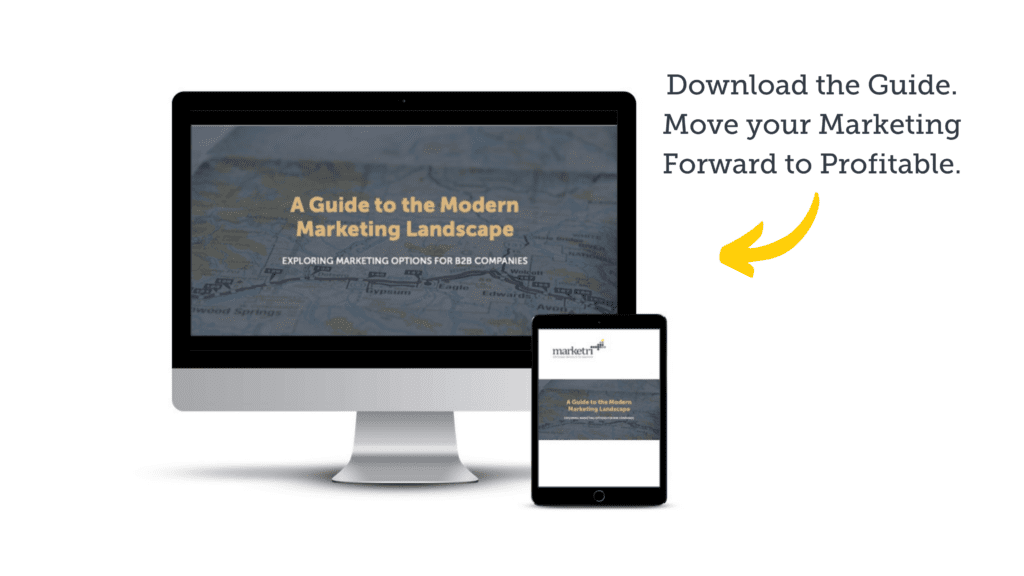Start Your Digital Marketing Transformation: 3 Essential Steps
We’ve talked a lot on our blog about what happens when you take on a marketing transformation. Companies that have tried to scale up marketing internally without success have shifted their way of thinking and realized the benefits of building a scalable team with fractional marketing. From there, it’s easier to align marketing talent with strategy and flex as needed to fit a changing market.
But that’s only one part of the equation. True marketing transformation involves a digital marketing transformation as well, one that’s focused on having the right technologies at the foundation of your strategy for long-term growth and flexibility.
Here are the steps you should take to get your tech stack to be scalable, connected, and optimized for ease-of-use.
1) Choose established technologies for your foundational tech stack.
At Marketri, we’re all about innovation. It’s great to see new MarTech hitting the market every day—but if you’re a middle-market company that’s primed for growth, is it really worth the risk?
There are times to take a chance on a new marketing technology. But as you build your foundation for the future—especially if you’re in high-growth mode—a more established tech stack is the way to go (at least for the essentials).
New technology is buggy, feature-light, and not guaranteed to receive the continuous funding needed to improve. Instead, choose the technology you know will be there with you for your next step. Here are some of the essentials we recommend (and what you should avoid).
Marketing Automation Platform & Customer Relationship Management (CRM)
Email marketing is the lifeblood of lead nurturing. When you get new leads, you want to keep in touch and stay top-of-mind, even if they’re not ready to buy. And a marketing automation platform is the best way to make that happen.
Many companies choose platforms like Constant Contact or Mailchimp for their email marketing. But these may not be the most scalable options for middle-market companies focused on getting new leads. These platforms don’t always allow for the complex automation you need to keep in touch with leads at different stages of the buyer journey via:
- The ability to send targeted emails based on lead behavior
- The ability to set up complex nurture programs
- A/B testing and other ways to optimize your email marketing
- Integrations with your CRM and other systems
- Reporting tools to help you track your progress
When choosing a marketing automation platform, it’s tempting to look solely at price, but a well-established platform like Hubspot (our favorite) is a great starting point with flexible pricing options that can grow with you. It’s also a CRM (customer relationship management) system, which means sales and marketing teams can work together in one place to manage their leads and customers.
CMS (Content Management System)
A CMS is just a fancy term for the back-end of your website. If you’re a founder, you’ve probably got many skills—but web developer likely isn’t one of them. As a result, there’s a good chance you’ll hire a developer to build your website. And if you’re like most people, you’ll trust that the developer will choose the right content management system to build it on.
More than likely, your website developer will choose the right CMS—for them. But whether or not it’s the right back-end for your ongoing needs is another story.
As your company grows and you have more people on board, it’s helpful to have the ability to update your website on demand. When services change, when new products are added, when you need to post a job opening—all of these things require website updates. And if those updates must go through your developer, it can quickly become costly and time-consuming.
There are other options for backend development, but in our experience, WordPress + Elementor or Divi is the simplest and most user-friendly solution for small businesses. WordPress is the standard in web development, so there is plenty of help available for those who need tutorials on navigating its menus and settings. Elementor and Divi are both visual builders, tools added to WordPress that give you drag and drop capabilities so you can make changes to your website without having to touch any code.
So don’t let your developer build on an unfamiliar or custom CMS. Having your developer set up your website on WordPress with one of these visual builders in place will save you a ton of headache in the long term.
Project Management
Finally, an essential technology for marketing is undoubtedly project management. This includes tools like Asana, Teamwork, and Basecamp. They help you keep track of deadlines, to-dos, and progress on projects. They also make it easy for team members to communicate with each other and stay up-to-date on the status of a project. And many modern tools can even integrate with your tech to make it easy to manage everything in one place.
As a marketing firm, we use these tools every day to manage our campaigns and projects. And we’ve found them to be invaluable in helping us stay organized and on track. Running your marketing department like an agency can be a game-changer for your business. It allows you to focus on your core competencies and outsource the rest. And it gives you the structure and processes you need to run efficient, effective campaigns that drive results.
2) Get things connected.
Now that you’ve got your core technologies in place, it’s time to get them talking to one another. That way, you can start to automate some of your marketing tasks and free up your team to focus on more strategic initiatives.
This will look different for every company because not every company is using the same digital marketing channels and tools. However, here are a few of our recommendations that commonly come in handy for our clients:
- Use your marketing automation platform to track activity on your website. One of the beauties of marketing automation technology is that you can track every move your website visitors make. Follow directions like these from Hubspot to connect your CRM (marketing automation platform) to your CMS (website back-end).
- Add social media channels to your marketing automation. Connect your Twitter, Linkedin, and other social media accounts to your marketing automation platform to track your engagement and automatically draft and schedule social media updates.
- Connect your website forms. Your website forms are another key part of your inbound marketing strategy. By connecting them to your marketing automation platform, you can track every form submission and automatically add those leads to your contact lists. You can even connect these to your project management system with built-in integrations or integration tools like Zapier.
3) Optimize your technologies for success.
Finally, whenever possible, you should try to set up your tech tools for optimal organization and scalability from the very beginning. This will make it much easier to keep your marketing strategy moving forward as you scale your business.
- Import your contacts. Your marketing automation platform should make it easy to import your contacts from a variety of sources, including your email list, CRM, and social media. If you have a lot of contacts, you may want to consider using a tool to help you clean and organize your data before importing it. If you’re looking to add new contacts, consider a data intelligence tool like ZoomInfo.
- Create contact lists. Once your contacts are imported, you can start organizing them into contact lists. You may segment your list by lead status (e.g., hot, warm, or cold), buyer persona, industry, or by other criteria that makes sense for your business.
- Set up lead nurturing workflows. Lead nurturing allows you to automatically send targeted content and messages to leads based on their interactions with your website and other content. This is an excellent way to keep leads engaged with your brand until they are ready to buy. Workflows can be automatically triggered when someone fills out a form on your website.
- Start tracking SEO and other metrics. If search engine visibility is important to you, start tracking your SEO progress using a tool like SEMrush or even Google Analytics (free). This will help you identify which keyword phrases are bringing visitors to your site, so you can focus your content on topics that are most relevant to your business. You can also set up Hubspot to track metrics that are important to you, like website visits, form submissions, and email opens.
- Set up lead scoring. Use marketing automation to score and grade leads based on their interactions with your website and other online content. This helps you prioritize follow-up so that you’re connecting with the most interested and qualified prospects.
- Organize your project management system by project. Your project management tool should not include a series of random tasks. Your tasks should be organized into projects that make sense for your business. This will help you stay focused on the most important work, and it will make it easier to see how individual tasks fit into the bigger picture.
These are only a few of the most essential steps you can take to launch your digital marketing transformation and set up a foundational tech stack that’s primed for success. By following these steps, you’ll be well on your way to driving real results for your business.
Get in touch to learn more about how we can help you transform your marketing efforts—from strategy to content to digital marketing and your tech stack.
Check out the latest:






